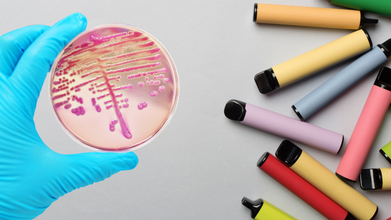- Health Conditions A-Z
- Health & Wellness
- Nutrition
- Fitness
- Health News
- Ayurveda
- Videos
- Medicine A-Z
- Parenting
After Criticism From Doctors, Sonali Bendre Explains Her View on Naturopathy For Cancer Treatment

Credits: Wikimedia Commons
Sonali Bendre, actor, who is known for talking about her cancer journey, inspiring other survivors to talk about it too, has found herself at the center of a heated debate after she spoke how naturopathy and autophagy helped her in her cancer recovery.
Bendre, who was diagnosed with stage 4 metastatic endometrial cancer in 2018, wrote on X that she believes autophagy played a role in her healing journey. Her post quickly drew sharp criticism from several doctors.
Doctors Point Out That Cancer Remission Came Through Medical Treatment
Members of the medical community reminded her that her remission was the result of evidence-based cancer treatments, including chemotherapy, radiation and surgery. Many emphasized that autophagy is not a recognized medical therapy and should not be presented as one.
One post from hepatologist Dr Cyriac Abby Philips on X said, “Your cancer went into remission after chemotherapy, radiation, and surgery at an advanced cancer treatment hospital. Not because of Naturopathy. Not because of autophagy. Because you have the option and privilege to opt for the best treatments from scientific practice to help you.”
Bendre Clarifies Her Stand
Following the criticism, Bendre clarified that she was sharing her personal experience as a survivor, not medical advice. She wrote that her journey included elements she explored with the help of her naturopath, and these practices were only part of her overall healing process. In her words, “I have never claimed to be a doctor, but I am certainly not a quack either. I am a cancer survivor, someone who has lived through the fear, pain, uncertainty, and rebuilding that the disease brings.”
What Autophagy Actually Is
Autophagy is a natural process in which the body breaks down and recycles old or damaged cell components. Cells contain various structures that help them function, and over time some of these structures wear out. Autophagy acts like a clean-up and recycling system. It allows cells to dismantle faulty parts and reuse the useful components to maintain healthy cell function. Anything that cannot be used is removed by the cell.
This process is an important quality control mechanism. If too much cellular waste builds up, it can interfere with normal cell activity. Autophagy helps keep cells efficient and healthy. The scientific understanding of autophagy grew significantly after Japanese biologist Yoshinori Ohsumi won the Nobel Prize in Medicine in 2016 for his work uncovering how it works. While autophagy is essential for survival, it is not considered a medical treatment for diseases.
Can Autophagy Treat Cancer?
Experts explain that autophagy plays a complicated role in cancer. In the early stages, it may help prevent tumor formation by clearing damaged components. However, in established cancers, the same process can allow tumor cells to survive stress and become more resistant to treatments like chemotherapy.
Disclaimer: Please consult a qualified doctor or oncologist before choosing any treatment for cancer. Health and Me does not endorse alternative therapies as substitutes for evidence-based medical care. This article is based on publicly available information. All medical conditions should be evaluated and managed under the guidance of a licensed healthcare professional.
E-Cigarettes Carry Fecal Bacteria Like E. Coli And More, More Details Inside

Credits: iStock and Canva
What if you are told that the vape you are using contains bacteria found in poop. You read that right. According to a study conducted by HAYPP along with Microbiologist Reynold Mpofu at BioLabTests, bacteria like staphylococcus and bacillus were found on vape, as well as fecal bacterium, E. coli is found on vape, which is often found in public bathroom.
What Did The Study Find?
More than 100 million people worldwide use e-cigarettes or vapes, and at least 1 in 6 people vape in toilet. Furthermore, vapes are rarely cleaned, and thus become germ hotspots.
The study found that vape mouthpieces are highly contaminated with bacteria. More than 1.5 million colony-forming unites or CFUs were identified on the vape mouthpiece, the maximum amount measurable by the lab, carrying as many as 2,300 times more bacteria than a public toilet, which has 50 CFUs per square inch.
“Laboratory analysis revealed that the mouthpiece is the dirtiest component of the vape. This isn’t surprising given that the human mouth, largely considered to be one of the ‘dirtiest’ parts of the body, harbors approximately 700 species of bacteria, that amounts to billions of individual bacteria,” said Mpofu.
The study was able to identify a range of bacteria, including skin microbes to gut bacteria like E.coli.
Also Read: UK Investigates Impact Of Vaping On Its Young Users
The Species Identified
The study identified these following bacteria on the vape:
- Bacillus: commonly found in dust and the air
- E.coli: indicates possible fecal contamination
- Yeast and mold: can cause respiratory irritation
- Staphylococcus: usually harmless, but could cause infection
- Enterococcus: intestinal bacteria that can persist on surfaces
The study was also able to identify bacteria on the vape body. The lab also observed a rapid microbial growth between just 2 to 3 days of use. These colonies could be seen multiplying thousand of times over.
While many of these are found on human skin or surrounding, some are intestinal bacteria, like aforementioned, E.coli, and Enterococcus, which points towards unwashed hands, explaining the transfer on the surface.
“Much like phones, vapes are frequently handled and placed on a variety of surfaces, allowing germs, oils, and dirt from hands, pockets and various environments to latch on the device. The findings confirmed the presence of bacteria, including E. coli and Enterococcus, on the vape body, likely arising from inadequate hand hygiene or the transfer of microorganisms from bathroom environments or other contaminated surfaces,” said Mpofu.
Read: Why Is My Idea Of Break Is To Have A Smoke?
The Timeline Of Bacteria Development
The first signs of microbes start to appear within the first day of buying a brand new vape, especially around the mouthpiece.
By day three, the vape accumulates more than 2,300 times the microbial load typically found on a toilet seat.
By the seventh day, bacteria like E.coli. and Enterococcus and other fecal indicators are detected on the mouthpiece and vape’s body. Mould and bacteria are also found on levels.
By day 14, despite no new use or cleaning, the vape remains heavily contamination. The contamination does not fade overtime.
As The Weather Gets Cold, Your Teeth Might Feel It More Than You Think, Says Doctor

Credits: iStock
The UK recorded its coldest autumn so far when the temperatures fell as low as -12.6C in Scotland. This was the lowest recorded in November from the last 15 years. The mercury also fell to -7.6C in Wales, -6C in Northern Ireland and -6.7C in England. Cold health alters have been issued in England. The UK Health Security Agency (UKHSA) has issued amber cold-health alerts for North West, North East, and Yorkshire and Humber, while other areas are under yellow alerts.
With this new developments, a Yorkshire dentists has pointed out that cold weather could, in fact, impact one's dental health.
Dr Abdul Dalghous, a dentist at Yorkshite Dental Suite said that chilly weather can trigger changes inside your mouth. Even if you have not notices them before, the change in weather and the temperature drop could negatively impact your dental health.
What Does The Doctor Say?
Sensitivity
The doctor says that there could be sudden sensitivity that one can feel when the weather is cold outside. "If you feel a sharp, almost electric twinge in your teeth when you breathe in icy air, it may be a sign that your enamel is under strain," explains the doctor.
Dr Dalghous explains that sudden cold exposure could make teeth contract quickly, irritating the nerves inside the tooth.
Teeth Ache
The cold weather can slightly weaken your immune system, making you more susceptible to illnesses such as colds. The doctor explains, "It’s very common for sinus pressure to feel like a toothache. This is due to your sinuses swelling and pressing on the roots of your upper teeth, often creating a dull, aching sensation. Many people mistake this for dental pain when the real culprit is winter congestion."
Dry Mouth
Another common experience during winters is having a dry mouth. This happens because cold air tends to be less humid and thus breathing it in through your mouth could lead to a drier mouth than usual. "Saliva acts as your mouth's natural defense system, so, when levels drop, your teeth become more vulnerable to sensitivity, plaque build-up and decay," the doctor notes.
Pain While Drinking Cold Beverages Or Eating Cold Food
Winter weather could further amplify the discomfort that is caused by cold food or drinks. "If a sip or bite of a chilled snack causes pain that lingers, it could point to underlying issues such as enamel erosion, cavities or exposed dentine that are becoming more noticeable in colder weather.”
Small Cracks Could Be More Noticeable
Teeth naturally expand and contract when exposed to temperature shifts, and winter tends to make these changes more intense. Over time, this added stress can lead to tiny hairline cracks in the enamel. You may not spot them, but you might feel rough spots, sudden sensitivity in one area, or small chips you never noticed before.
Dr Abdul adds: “To help ease these changes, we recommend breathing through your nose where possible and avoid biting into cold foods. When it comes to your oral hygiene ensure you’re brushing twice a day using toothpaste designed for sensitivity and flossing. Following these will help your teeth during this cold weather!”
Are You Still An Adolescent At 32? Study Says Yes

Credits: iStock
Your adolescence lasts well up to your 30s. A new, "cool" study as Prof Tara Spires Jones, tells BBC, noted that the human brain does not follow a simple, steady path from birth to old age. Instead, it moves through five clear phases, each marked by a shift in how its networks connect and communicate. The study is conducted by the researchers from the University of Cambridge, who analyzed thousands of brain scans to track how neural connections strengthen, weaken, and reorganize over time.
This large study involved nearly 4,000 people between infancy and age 90 and has now mapped these transitions, offering new insights into why periods of life differ so much in terms of learning, behaviors, and vulnerability to mental health conditions.
Their work shows that the brain remains in an adolescent state far longer than earlier believed and reaches a peak of efficiency only in the early thirties. The findings, published in Nature Communications, highlight striking turning points at the ages of nine, 32, 66 and 83.
The Five Phases Of Brain
Childhood: Birth to Age Nine
The study showed that during childhood, the brain grown rapidly, however, it also begins trimming the vast numbers of synapses formed in early life. This is what helps the brain decide which pathways truly matter. However, this period is not very efficient. It resembles a child wandering without a fixed route, exploring freely rather than moving directly from one point to another. The purpose is exploration, not precision.
Adolescence: Age Nine to 32
A dramatic shift begins around age nine. The brain enters a long stretch of heightened efficiency as it reorganizes its neural networks with remarkable speed and intensity.
This is the phase where mental health vulnerabilities often emerge, since the brain is restructuring at an unusually rapid pace.
This part of the study also breaks the conventional idea that associated adolescence typically with the teenage years. Modern neuroscience suggests it extends into the twenties. This study pushes that boundary even further, indicating that the adolescent phase may last all the way to 32.
During this time, the brain reaches its most efficient point, and many cognitive abilities are thought to peak.
Adulthood: Age 32 to 66
After the long adolescent stretch, adulthood brings stability. The study shows that adulthood actually comes from the age 32, again a shift from what conventionally was believed adulthood to be. This is the brain’s most settled era, lasting more than three decades. Change continues, but at a gentler pace and in a more predictable pattern. The efficiency gained earlier begins to level out. Many people recognize this phase as a period when their cognitive strengths, personality and sense of self feel most consistent. The fireworks of earlier development give way to a steady rhythm.
Early Aging: Age 66 to 83
The period after 66 marks the beginning of early ageing. It does not arrive as a sudden decline. Instead, there are subtle shifts in how different parts of the brain coordinate.
Rather than functioning as one unified network, the brain begins to break into clusters of regions that work more closely within their own groups. It is similar to a band whose members start pursuing individual projects while still occasionally performing together.
Although the study focused on healthy brains, this is also the age when conditions linked to ageing, such as high blood pressure and dementia, begin to appear more frequently.
Late Aging: 83 And Beyond
The final phase begins at around 83. Data for this group was more limited, since it is harder to find older adults with no underlying health issues. Even so, the scans show that the patterns seen in early ageing become more pronounced. The brain’s networks continue to drift apart, and communication between regions becomes less synchronized.
© 2024 Bennett, Coleman & Company Limited

